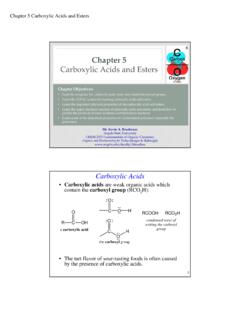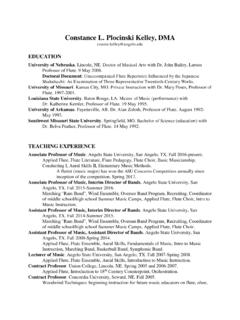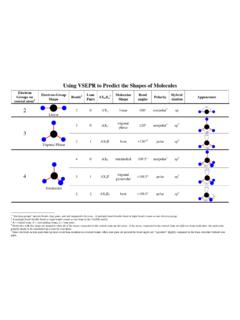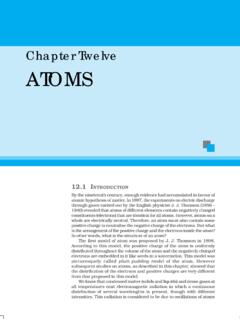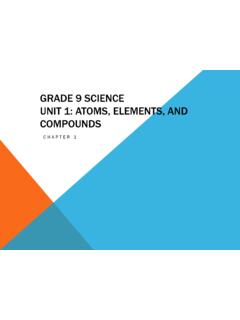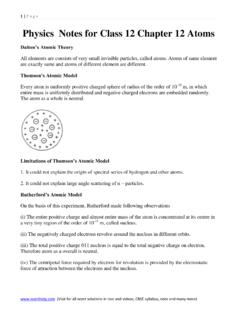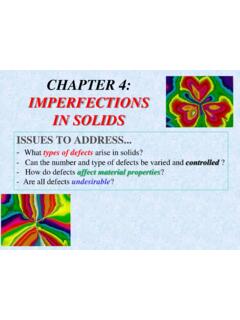Transcription of Chapter 1 Organic Compounds: Alkanes - Angelo State …
1 Chapter 1 Alkanes1Mr. Kevin A. BoudreauxAngelo State UniversityCHEM 2353 Fundamentals of Organic ChemistryOrganic and Biochemistry for Today (Seager & Slabaugh) Objectives: Learn the differences between Organic and inorganic compounds. Learn how to identify isomers of Organic compounds. Learn how to write condensed, expanded, and line structures for Organic compounds. Learn how to recognize the alkane functional group in Organic compounds. Learn the IUPAC system for naming Alkanes and cycloalkanes. Learn the important physical and chemical properties of the 1 Organic Compounds: Alkanes2 Organic chemistry nowadaysalmost drives me mad.
2 Tome it appears like a primevaltropical forest full of themost remarkable things, adreadful endless jungle intowhich one does not dareenter, for there seems tobe no way W hlerChapter 1 Alkanes234 What Do We Mean By Organic ? In everyday usage, the word organiccan be found in several different contexts: chemicals extracted from plants and animals were originally called Organic because they came from living organisms. Organic fertilizers are obtained from living organisms. Organic foods are foods grown without the use of pesticides or synthetic fertilizers.
3 In chemistry, the words Organic and Organic chemistry are defined a little more precisely: Chapter 1 Alkanes35 What is Organic Chemistry? Organic chemistryis concerned with the study of the structure and properties of compounds containing carbon. All Organic compounds contain carbon atoms. Inorganic compounds contain no carbons. Most inorganic compounds are ionic compounds. Some carbon compounds are not considered to be Organic (mostly for historical reasons), such as CO, CO2, diamond, graphite, and salts of carbon-containing polyatomic ions ( , CO32-, CN-).
4 Inorganic chemistry is the study of the other elements and non-carbon containing Periodic Table There are 92 naturally occurring elements , and many artificial ones, in the (in)famous Periodic Table:K Ca Sc Ti V Cr Mn Fe Co Ni Cu Zn Ga Ge As Se Br KrRb Sr Y Zr Nb Mo Tc Ru Rh Pd Ag Cd In Sn Sb Te I XeCs Ba La Hf Ta W Re Os Ir Pt Au Hg Tl Pb Bi Po At RnCePrNdPmSmEuGdTbDyHoErTmYbLuThPaUNpPuA mCmBkCfEsFmMdNoLrNaMgAlSiPSClArLiBeBCNOF NeHHeFrRaAcRfDbSgBhHsMtDsRgCnI AII AIII B IV B V B VI B VII BIII BI BII BIII A IV A V A VI A VII AVIII A1234567 LanthanidesActinidesFlLvChapter 1 Alkanes47 The Periodic Table of Organic Chemistry Organic chemists look at the Periodic Table a little differently.
5 CrMnFe CoNiCuBrPdIPtMgAlPSClBNO FHC8 Origins of Organic Chemistry Organic literally means derived from living organisms Organic chemistry was originally the study of compounds extracted from living organisms and their natural products. It was believed that only living organisms possessed the vital force necessary to create Organic compounds ( vitalism ). This concept started to change in 1828 after Friedrich W hler showed that it was possible to make urea, a known Organic compound from a mineral source:NH4+ -OCNHeatAmmonium CyanateUreaCONNHHHHC hapter 1 Alkanes59 Origins of Organic Chemistry What this and later experiments showed was that Organic molecules even those made by living organisms can be handled and synthesized just like minerals and metals What was special about these molecules was that they contained the element s So Great About Carbon?
6 Carbons atoms can be linked by strong, stable covalent carbon, CCcarbon cation, C4+Ccarbide anion, C4-CHHHHCHHHHC hapter 1 Alkanes611 What s So Great About Carbon? Carbon atoms can form stable bonds to many other elements (H, F, Cl, Br, I, O, N, S, P, etc.). Most Organic compounds contain a few hydrogens, and sometimes oxygen, nitrogen, sulfur, phosphorus, etc. Carbon atoms can form complex structures, such as long chains, branched chains, rings, chiralcompounds (having a particular handedness ), complex 3D shapes, etc. Because of this variety in bonding and complexity, carbon atoms can form a tremendous variety of compounds.
7 More than 16,000,000 Organic compounds are known, as opposed to about 600,000 inorganic s So Great About Carbon? Complex Organic compounds can perform a number of useful biological functions(vitamins, carbohydrates, lipids, proteins, enzymes, ATP, DNA, RNA are all Organic compounds) which are studied in biochemistry. Complex Organic compounds are present in the foodswe eat (carbohydrates, proteins, fats, etc.) Most medicines, whether they come from a chemical plant or a green plant, are Organic compounds. Most fuelsare Organic compounds (wood, coal, natural gas, gasoline, kerosene, diesel fuel, oil, and other petroleum-based products).
8 Complex Organic compounds are also useful in technology (paints, plastics, rubber, textiles, etc.). Chapter 1 Alkanes713 Organic vs. Inorganic Compounds Organic compounds are held together by covalent bonds, while inorganic compounds are held together by ionic chlorideNa+Cl Na+Cl Na+Cl CHHHHNa+Cl Na+Na+Cl CHHHHCl Na+Cl Cl Na+14 Organic vs. Inorganic CompoundsPropertyOrganicInorganicBonding within moleculesCovalentOften ionicForces between moleculesGenerally weakQuite strongNormal physical stateGases, liquids, or low melting-point solidsUsually high melting-point solidsFlammabilityOften flammableUsually nonflammableSolubility in waterOften lowOften highConductivity of aqueous solutionsNonconductorConductorTable of typical organicand inorganic 1 Alkanes81516 Atomic Orbitals on Carbon A carbon atom does not form ions easily, since it has four valence electrons (1s22s22p2).
9 It satisfies the octet rule in compounds by sharing electrons. These are the orbitals that exist on atomic carbon (not connected to anything).sorbitalporbital2s2pEnergy1sCh apter 1 Alkanes917 Hybrid Orbitals When carbon atoms form bonds with each other, we describe the resulting bonds using hybrid orbitals, which are formed by mixing (hybridizing) the carbon s atomic orbitals. (Linus Pauling, 1950s) When carbon atoms bond to 4 other atoms, the 2sorbital and all three 2porbitals in the valence shell combine to produce four sp3hybrid orbitals:++++++2s1 atomicorbital2p3 atomicorbitalssp34 hybridorbitals182s2pEnergy1ssp31shybridi zationHybrid Orbitals All four sp3orbitals are at the same energy level, with one electron in each hybrid 1 Alkanes1019 The Shape of an sp3 Carbon In order to get as far away from each other as possible (thus minimizing electron-electron repulsions), the sp3orbitals are arranged in the shape of a tetrahedronaround the central carbon atom, with bond angles of.
10 Sp3sp3sp3sp320 The Shape of an sp3 CarbonChapter 1 Alkanes1121 Bonding in Ethane Bonds arise from the overlapof orbitals on adjacent atoms. End-on-end overlap of sp3orbitals produces a -bond(sigma bond). All single bonds are -bonds. Free rotationis possible around -bonds. Each carbon in the ethane molecule, CH3CH3, is sp3-hybridized and tetrahedral in shape. Free rotation is possible around the C C bond. (See next slide)22 Bonding in Ethane (CH3CH3)CHCHHHHHCHCHHHHHC hapter 1 Alkanes1223 Carbon Chains Each carbon atom can form four bonds, either to other carbon atoms, or to different atoms (such as H, O, N, S, P, etc.)


